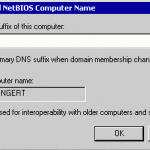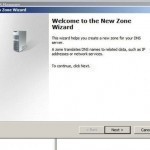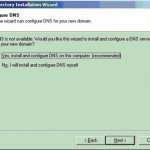DNS is the primary name registration and resolution service in Windows 2000 and Windows Server 2003. It provides a hierarchically distributed and scalable database, name registration, name resolution and service location for Windows 2000 and Windows Server 2003 clients, and locates domain controllers for logon. A DNS server is a computer running the DNS Server service that provides domain name services. The DNS server manages the DNS database that is located on it. The information in the DNS server’s database pertains to a portion of the DNS domain tree structure Read More
Renaming Domains

An Overview of the Domain Renaming Feature With the Windows NT 4 domain model, you had to completely rebuild an existing domain if you wanted to change the names of any of your existing domains. In Windows 2000 domains, you also have to create a new domain but the Active Directory Object Manager can be used to migrate existing users, groups and computers into the new domain. The Active Directory Object Manager plays a vital role in moving the contents of existing Windows 2000 domains into new domain structures. The Read More
Understanding Host Name Resolution
Understanding the Purpose of Host Names In TCP/IP based networks, the packets that are transmitted over the network contain the following IP addresses: The IP address of the computer sending the packet The IP address of the destination computer intended to receive the packet. The IP address information is used to forward the packet to the destination computer. The IP addresses of computers therefore have to be both unique and correct so that they can be forwarded to the correct destination. IP addresses also contain the following important information: Network Read More
DNS Server Roles
DNS Server and DNS Server Roles Overview Before DNS, HOSTS files were used to resolve host names to IP addresses. The HOSTS files were manually maintained by administrators. The HOSTS file was located on a centrally administered server on the Internet. Because of the shortcomings of the HOSTS files, DNS was designed and introduced. From the days of Windows NT Server 4.0, DNS has been included with the operating system. DNS is a hierarchically distributed and scalable database. DNS provides name registration, name resolution and service location for Windows 2000 Read More
Configuring DNS Clients
Configuring DNS Client Settings Configuring DNS client computers typically entail the execution of the following administrative tasks: Setting the client computer names for each computer. The computer names that you configure should not be greater than 63 bytes. The name can only include: Uppercase letters; A – Z Lowercase letters; a – z Numbers; 0 – 9 Hyphens Configure a primary DNS suffix for the computer. The primary DNS suffix of the computer is the name of the Active Directory domain that the computer is a member of, by default. Read More
Securing DNS

Common threats to DNS servers include: Denial-of-service (DoS) attacks: DoS attacks occur when DNS servers are flooded with recursive queries in an attempt to prevent the DNS server from servicing legitimate client requests for name resolution. A successful DoS attack can result in the unavailability of DNS services, and in the eventual shut down of the network. Footprinting: Footprinting occurs when an intruder intercepts DNS zone information. When the intruder has this information, the intruder is able to discover DNS domain names, computer names, and IP addresses which are being Read More
Planning DNS Zone Replication

A DNS zone is the contiguous portion of the DNS domain name space over which a DNS server has authority or is authoritative. DNS zones contain either domains or subdomains. The DNS namespace can be divided into multiple zones. Users can even host all their zones on a single DNS server. The Windows Server 2003 DNS Server can host up to 20,000 DNS zones. A DNS zone contains a zone database that contains resource records for all the domains within the zone. Zone files are used if DNS is not Read More
Integrating the DNS Server with DHCP and WINS
Configuring DNS Server and DHCP Integration Windows 2000, Windows XP, and Windows Server 2003 clients can dynamically update their own resource records in Windows Server 2003 DNS. DHCP can also be used to configure down-level clients as DHCP clients. To enable the DHCP server to dynamically update clients; Click Start, Administrative Tools, and then click DHCP to open the DHCP console. Expand the DHCP server node in the console tree. Select and then right-click the DHCP scope, and then click Properties on the shortcut menu. Click the DNS tab. The Read More
How to Setup a Windows DNS Server

A Domain Name Server (DNS) is a computer that uses networking software in order to save a database of network IP addresses and domain names for other Internet hosts. A DNS helps client computers use the web more efficiently by storing previous address look-ups, which allows them to surf the Internet faster. Older Windows Servers used the Windows Internet Name Service (WINS) for name resolution on the local network. It is recommended that a DNS Server be installed with the Windows 2008 server in order to provide a higher quality Read More
How to Fix a “Cannot Find Server or DNS” Error

A server is a computer that ‘serves’ the network that it is connected to. It performs functions that are useful to the network. For example, there are file servers that store data and print servers that handle the network printing jobs. Businesses and other institutions often use servers to store important, possibly confidential, information and allow multiple users to access a single database via the Internet. Servers are also used for web hosting purposes to allow users to create a website and store that website’s files on a public storage Read More


Share on: